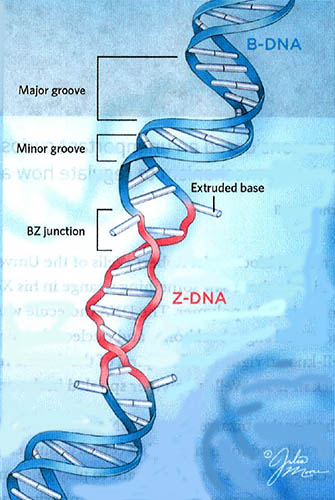A Z-DNA configuration of DNA is
the left-handed version
of the WC model. The major and minor grooves do show a
little difference in width
and every other base in a Z-DNA stretch has a different orientation relative
o the sugar-P backbone resulting in Z-DNA having a
Zig-Zag shape. Z-DNA exists transiently in short
stretches of up to 100 base pairs.
The site where the DNA molecule switches chirality is
known as the B-Z junction.
At this point in the DNA polymer, on A-T pair projects
to the outside of the double helix.
Using
protein antibodies to Z-DNA, P. Shing Ho found some 800 Z-DNA sequences across the
Human genome, that seem to be clustered near the start
of many eukaryotic genes. Z-DNA does not seem to occur
within protein coding gene sequences.
A. Herbert (1995) discovered a
protein domain Za in a
Z-DNA binding protein (ADARI)
which binds to the backbone of this left handed
DNA. The ADARI-Za domain binds to double stranded
RNA and converts Adenine to
Inosine, that is read as Guanosine
and involved in double strand RNA formation.
Herbert's group (2019) studied
mutations in the ADARI
protein in the Za domain
regions that were associated with a number of inherited
inflammatory immune diseases, as Z-DNA is linked to the
interferon production.

